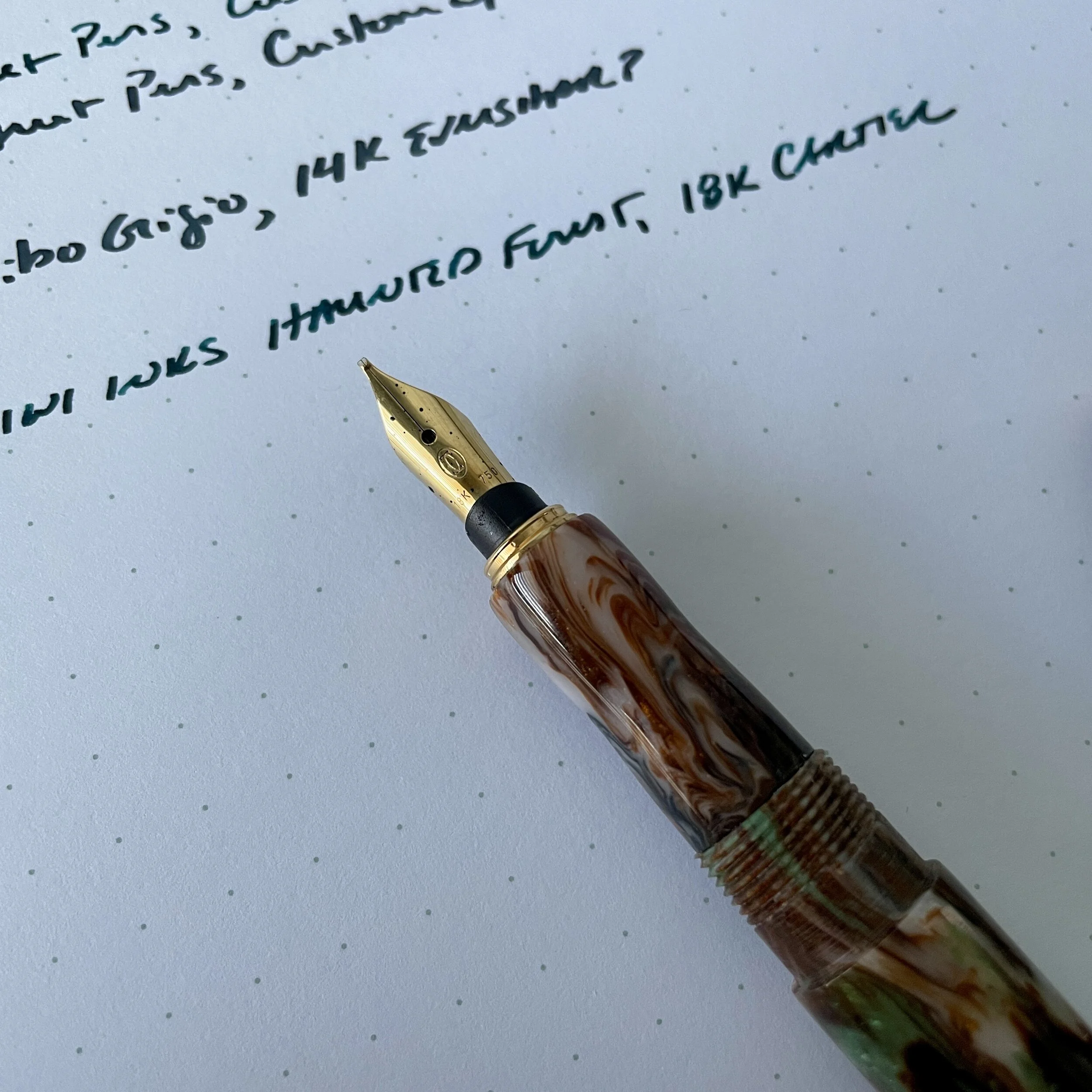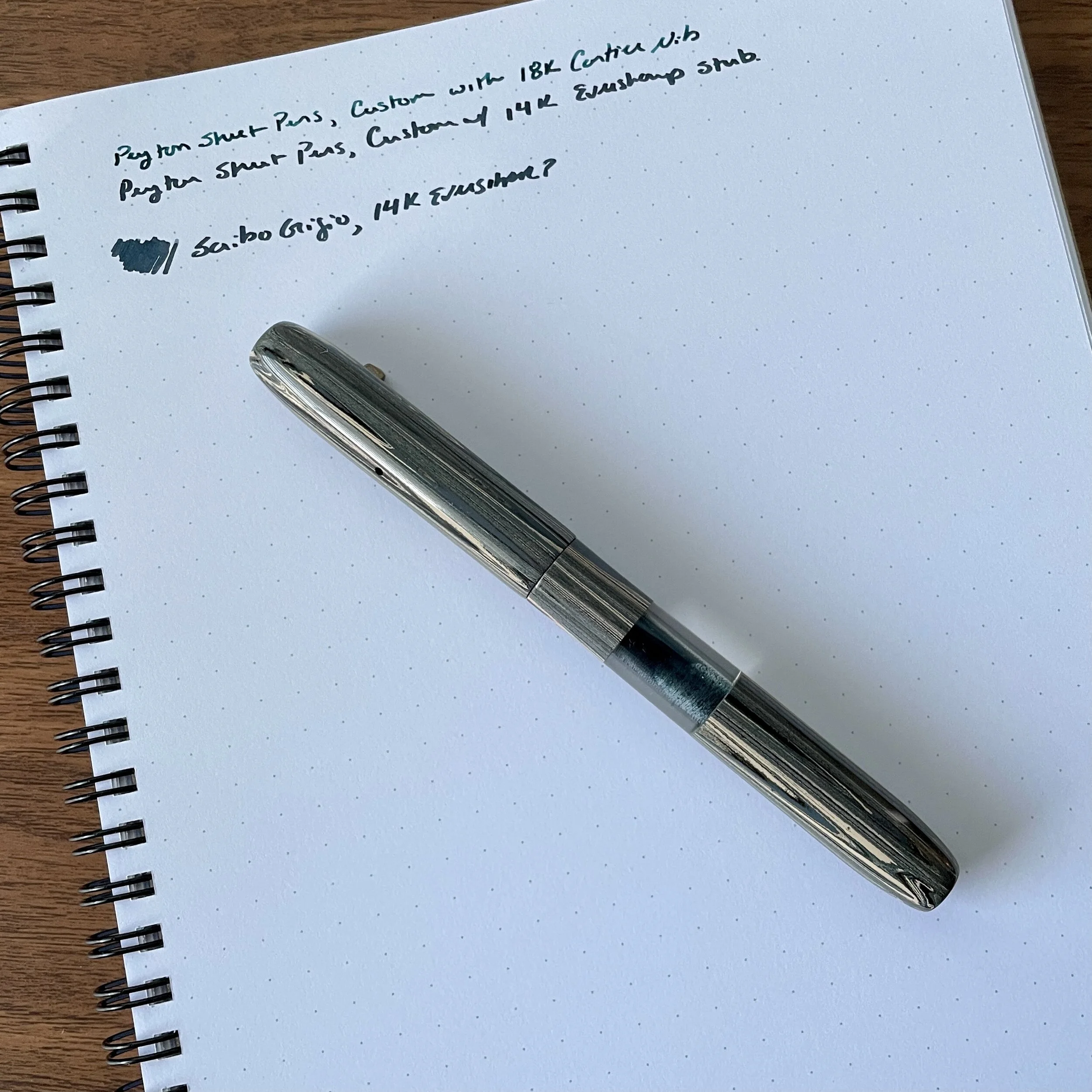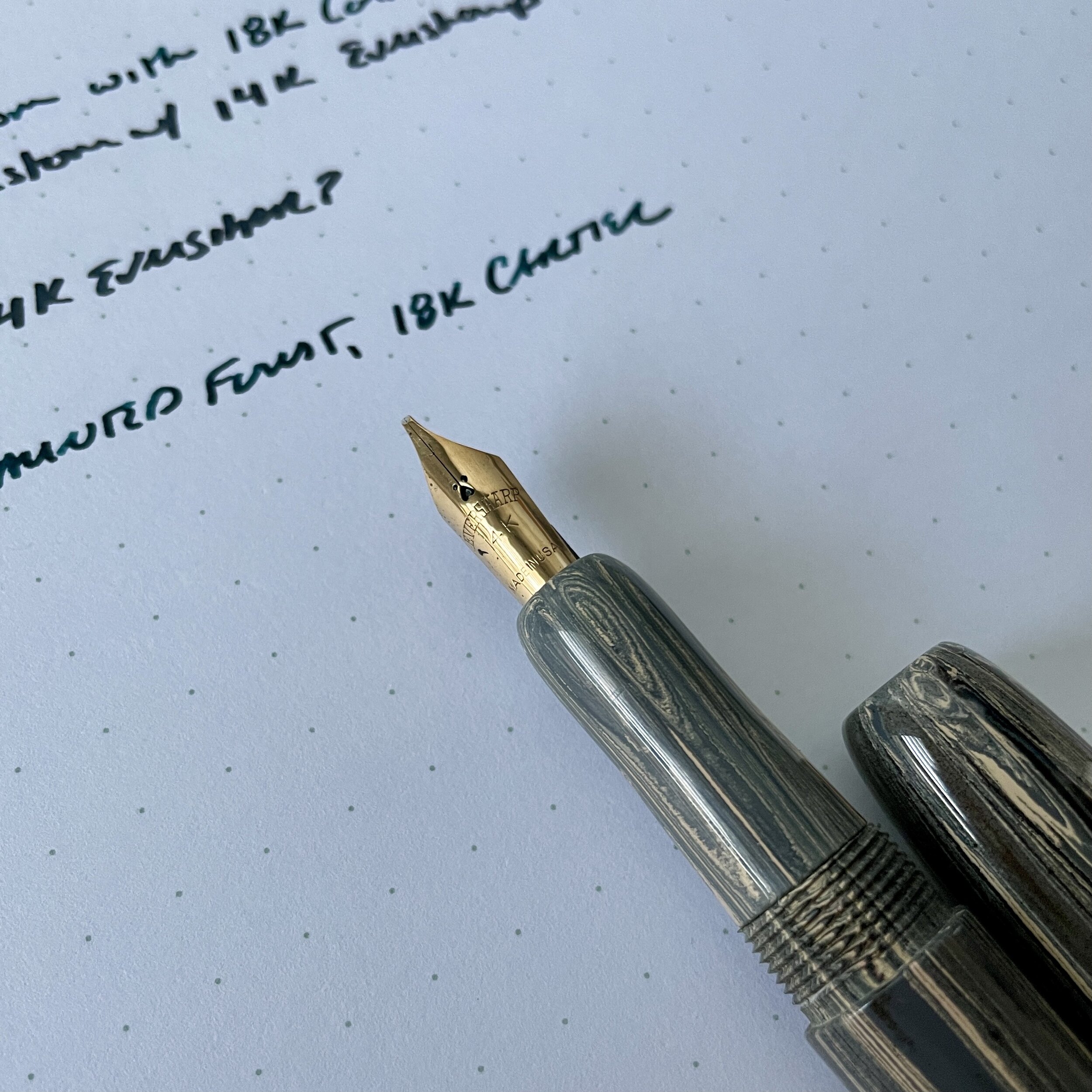My acquisitions at this year’s pen shows have leaned decidedly more vintage-heavy. There are a few factors playing into this. First, for the most part I’ve been uninspired by many of the modern releases from mainstream pen companies - not necessarily because the pens are bad, but simply because we’ve reached a point where innovation has plateaued. Thus, in addition to focusing on those smaller makers who continue to experiment, I’ve started looking backwards to an aspect of the hobby that I’ve dabbled in yet haven’t fully embraced: the vintage world.
All five pens from this lot are salvageable, and 4/5 have 14k nibs. The Kaweco is a new pen to which I added a vintage Mabie Todd 14k nib that I had in my parts bin .
Second, given the amount of time that I now devote to writing about and retailing stationery, I need to carve out some aspect of this hobby that’s pure fun for me. I plan to attend the Ohio Pen Show in a couple weeks, which is one of the premier vintage shows in the country, and is actually the first pen show I attended way back in 2012. In advance of this trip I thought it might be fun to not only show off some of my newer vintage acquisitions, but also provide some insight into how I approach vintage pens in general.
A close-up of the Olive Kaweco Sport with a vintage Mabie-Todd nib. Read more on what I’m doing here below.
My Recommendations For Enjoying Vintage Pens
Don’t Worry About Locating “Mint” Pens or Valuable Collectibles. Nearly all of the vintage pens I own would be deemed “user grade” by a serious collector. I’m totally fine with that. A 75+ year-old pen that’s served as a functional writing instrument for nearly a century should have some dings, scratches, and signs of use. Not only do they make me less reluctant to use a pen for fear of damaging it, these marks add character. In certain vintage watch circles, it’s considered a faux pas to overly restore and polish a vintage watch to where it looks like new, and I take the same approach to my pens. (User-grade specimens of common vintage pens like Sheaffer Snorkels and Parker 51s are also much easier on the wallet than new-old-stock or “mint” condition versions, and you can get them at extremely low prices if you purchase unrestored examples.)
Learn How to Restore Pens Yourself. To get seriously into vintage pens - and arguably, to have the most fun with them - it helps to learn a bit of basic pen repair. Most vintage pens use some variation of a sac-based filling system, which may need to be serviced periodically. Learning how to restore your own pens not only saves you money (and the inconvenience of having to ship off pens to get fixed), but in the course of doing your own work, you also learn how pens are made, the intricacies of vintage filling systems, and how they differ from the modern filling systems we use today. Repairs can range from simple and straightforward (lever filling pens like Esterbrooks) to time consuming and more complex (such as a Sheaffer Snorkel, some of which you can see in the stories on my Instagram profile). Many vintage pens are incredibly durable, including the Parker 51, 51 Special, and Super 21, and often require no restoration beyond a flush with water or bath in an ultrasonic cleaner to remove dried ink.
Swap Vintage Nibs into Modern Pens. While I would strongly advise against purchasing your first vintage pens on eBay or Etsy (unless you absolutely know the seller is reputable), it’s sometimes fun to buy a big lot of unrestored vintage fountain pens sold “as-is” or “for parts”. Usually you can get one or two salvageable fountain pens out of these lots, and the rest you can scavenge for spare parts for other restorations or - my favorite - for nibs and Frankenpens! Many vintage pens, even inexpensive ones, featured 14k gold nibs, some of which are compatible with the feeds and sections used today. You will need to experiment, and it will most certainly void your warranty, but this is a great way to add a luxurious gold-nib writing experience to a less expensive modern pen like a Kaweco Sport. As shown in the picture below, I swapped a Mabie-Todd No. 2 gold nib directly into a modern Kaweco Sport nib unit, so now my Olive Kaweco Collection pen has a 14k gold nib.
Don’t Baby Your Pens - Write with Them! As you can probably tell, I am not a traditional vintage pen collector. I purchase pens both to use them and to help me learn more about the history of writing instruments in general. Because I acquire user-grade pens and have a basic knowledge of restoration and repair, I’m much less hesitant to use my vintage writing instruments and carry them with me semi-regularly. (Most don’t handle airplane travel well, however. Fly with them un-inked.)
Learn About Your Pens. My interest in history, antiques, and “old” technology is what led me to the pen hobby in the first place, so it’s a bit ironic (and inexcusable) that I’ve let this part of the hobby slide. One thing I’ve started doing recently is keeping a “pen journal” about pens I’ve acquired - vintage and modern. For the vintage pens, I note the make, model, and approximate date of manufacture, as well was where I acquired it and how it was restored. I’ll also make notes about why I acquired each pen, what I know about its history, and why I found it interesting enough to add to my “collection.” I’m also considering adding photographs, keeping both a digital archive and a printed copy using my Fuji Instax or similar printer.
The Sheaffer Snorkel from the eBay lot shown above, disassembled and ready for restoration. While a Snorkel is a sac-filling pen, it has a more complex - yet fun - filling system that also requires the replacement of a gasket and an o-ring.
Further Reading
The internet serves as a repository for decades of vintage pen knowledge. Surf the forums at Fountain Pen Network, and/or visit dedicated vintage pen websites by specialists such as David Nishimura or Richard Binder. If you prefer to have a physical book or manual, Andy Lambrou’s “Fountain Pens of the World” is a great general resource that can be found secondhand, and there are several published guides that will walk you through the repair and restoration process.
I’ve written less about vintage pens over the years than I have about more modern writing instruments, but I did do a series titled “Vintage Pen Primer” in which I discussed some specific models. Check out Vintage Pen Primer, Part I; Part II (The Parker 51); Part III (Inks for Vintage Pens); Part IV (The Parker Vacumatic); and Part V: What About Just Opting for A Vintage Nib?
The Gentleman Stationer is supported entirely by purchases from the T.G.S. Curated Shop and pledges via the T.G.S. Patreon Program. This post does not contain third-party advertising or affiliate links.



